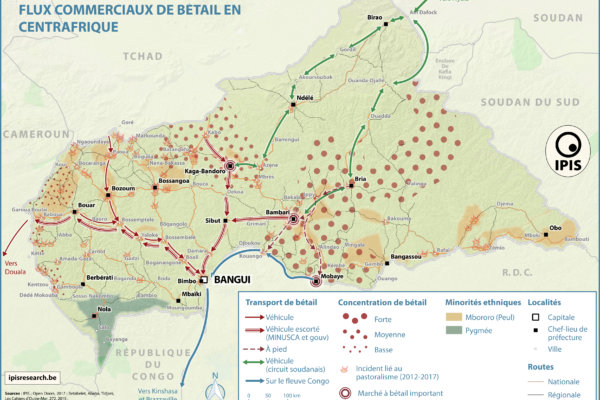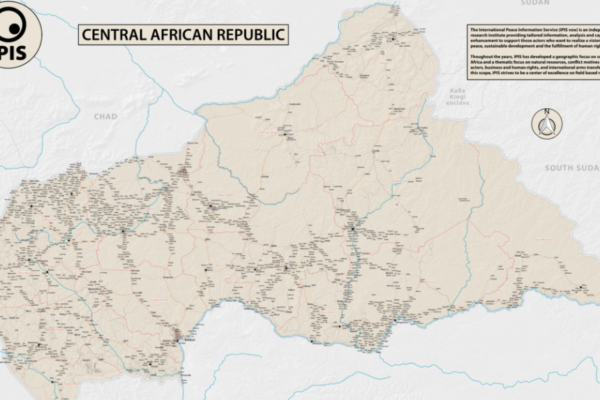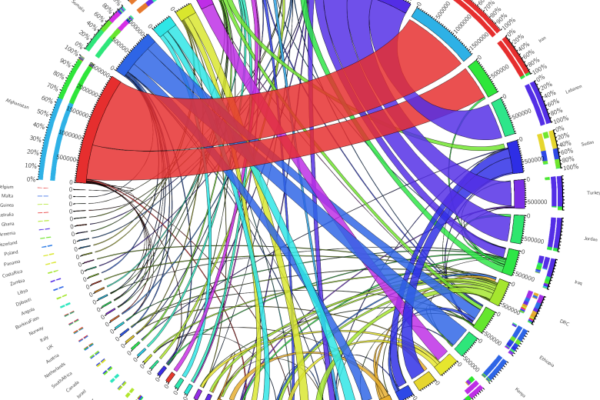Publications

“Everything that moves will be taxed”: the political economy of roadblocks in North and South Kivu (2017)
- Alexandre Jaillon, Janvier Murairi, Peer Schouten (DIIS/IPIS), Saidi Kubuya (ASSODIP) | December 6, 2017
IPIS puts roadblocks on the map as key mechanism of conflict funding besides natural resources, revealing its devastating scope in funding armed actors in Democratic Republic of Congo and Central African Republic Mapping over a thousand roadblocks, IPIS shows the shocking extent of armed predation on trade routes in conflict-ridden Central Africa. Roadblocks, IPIS claims, have netted armed groups

Pastoralism corridors in Central African Republic (2017)
- Alexandre Jaillon, Milan Nublat | December 1, 2017
While pastoralism can generates wealth and economic interdependence between farmers and cattle herders, it can also causes tension and conflicts. In the current Central African Republic crisis context, transnational livestock migrations, particularly by Chadian and Sudanese herdsmen to CAR, have led to clashes between pastoralists and the local population. IPIS has developed a map showing the main

Towards a multi-scale approach for an Earth observation based assessment of natural resource exploitation in conflict regions
- Elisabeth Shoepfer et al., Filip Hilgert | November 6, 2017
Environment and natural resources can be key elements in starting and fueling conflicts. IPIS researcher Filip Hilgert contributed to an article in Geocarto International (2017, vol. 32, n° 10) on a multi-scale approach for an Earth observation based assessment of natural resource exploitation in conflict regions. Download the full article Elisabeth Schoepfer, Kristin Spröhnle, Olaf Kranz, Xavier

Conflict Minerals in Eastern DRC (2017)
- Alexandre Jaillon | September 22, 2017
Printing maps of conflict minerals in Eastern DRC.

République Centrafricaine: Portait d’un territoire riche en crises (2012 – 2017)
- Alexandre Jaillon, Milan Nublat | September 19, 2017
This poster is a compilation of maps and graphics related to the situation in the Central African Republic. A map of natural resources and poaching corridors presents the known wealth of this country, often considered as conflict drivers in the absence of well functioning state authorities. A small map presents the current armed groups area of influence as well as the number of reported violent in

Annual report 2016
- IPIS | June 23, 2017
In its 2016 annual report, IPIS gives an overview of its research projects and activities. It covers the four research programmes that IPIS focusses on: natural resources, arms trade, conflict mapping and business and human rights. In 2016, IPIS continued to be a rally point for hard to get data on natural resources, often visualised in maps. Our flagship map for 2016 is the interactive map of art

Central African Republic – Road Map (2017)
- Alexandre Jaillon, Milan Nublat | June 1, 2017
In 2013 the Central African Republic entered a period of great instability. The predominantly Muslim rebel coalition, Seleka, seized power. A group of mostly Christian militias, the Anti-balaka, rose up to counter the Seleka. Years of atrocities, horrors and fighting followed. In 2016 a democratic election was held, a sign of hope for the people of the CAR. However, dissolved fractions of the Sele

Arms Trade Corridors to Burundi
- IPIS | May 5, 2017
Burundi has seen a period of unrest following the failed coup d’état by a Burundian general in May 2015. In order to better understand the situation, IPIS drafted a new map entitled ‘Arms transport to Burundi’, which puts the 2015 unrest in the geographical perspective of the Great Lakes region and in the relevant timeframe covering 2008 to 2015. The map highlights two important factors in the rec

Comprendre la spirale de la violence au Kasaï (2017)
- Alexandre Jaillon | April 25, 2017
Le Kasaï Central et trois autres provinces voisines sont en proie à des violences mêlant miliciens, policiers et soldats et ayant fait, selon un rapport récent des Nations Unies, plus de 200 morts. Depuis septembre, un soulèvement des partisans du chef coutumier Kamwina Nsapu, tué en août par les forces de l’ordre après s’être rebellé contre les autorités congolaises, a embrasé la région. L’ONU a

Pillage route: l’économie politique des barrages routiers à Walikale et Masisi (2017)
- Alexandre Jaillon, IPIS, Janvier Murairi, Peer Schouten (DIIS/IPIS), Saidi Kubuya Batundi | March 31, 2017
French version below – version française ci-dessous Roadblocks are a ubiquitous phenomenon in Eastern Congo. In an effort to map the scope of this phenomenon as well as its significance in the political economy of conflict, IPIS has embarked on a collaboration with the Danish Institute for International Studies. The point of departure is that control over the circulation of people and valua

Het conflict in de Centraal-Afrikaanse Republiek
- Fiona Southward, Peer Schouten (DIIS/IPIS) | January 27, 2017
In 2014 deed IPIS een uitgebreid ‘conflict mapping’ onderzoek om inzicht te krijgen in de veiligheidssituatie in de Centraal-Afrikaanse Republiek (CAR). Dit leidde tot de publicatie van een publiek toegankelijke webkaart over belangrijke conflictdynamieken. IPIS bracht de gewapende groepen, mensenrechtenschendingen, natuurlijke rijkdommen, vluchtelingenstromen en migratieroutes van veehouders in k

Analysis of the interactive map of artisanal mining areas in eastern DR Congo – 2015 update
- Ken Matthysen, Lotte Hoex, Yannick Weyns | October 25, 2016
The Belgian research group IPIS has collected data on 2026 artisanal mining sites in eastern DRC over the last couple of years. IPIS observed an armed presence in more than half of the mines. In an interactive map, updated in 2015, IPIS provides information about the on-site presence of armed groups and the Congolese army (FARDC) as well as indicators of the relative importance of the site. It als

Annual Report 2015
- IPIS | August 31, 2016
Download pdf or open with issuu reader http://issuu.com/ipisresearch/docs/2016_10_10_ipis_jaarverslag_2015_20

Accessible and Interactive: New Methods of Data Visualization as Tools for Data Analysis and Information Sharing in Transitional Justice Research
- Alexandre Jaillon, Tim Rosenkranz | March 24, 2016
Abstract The production and use of datasets is a growing area in transitional justice research. One constant limitation, however, is the way this data is visualized. Relying only on static graphics and tables, many of these datasets are insufficiently explored and analyzed, and remain inaccessible for other researchers. Interactive data visualization tools are an ideal method for overcoming this g

Mineral supply chains and conflict links in eastern democratic republic of congo
- Fiona Southward | November 25, 2015
Between 2009 and 2010 IPIS collected data on over 550 mining sites as part a conflict mapping exercise focusing on Eastern Democratic Republic of Congo (DRC). With the collaboration of Congolese researchers, IPIS collected the coordinates of the most important mining sites and information on on-site security in North and South Kivu provinces, Maniema, Northern Katanga and southeast Province Orient

Mapping Conflict Motives: the Central African Republic (2012-2014)
- Filip Hilgert, Lotte Hoex, Steven Spittaels, Yannick Weyns | November 21, 2014
In this study, IPIS analyses the conflict dynamics in the Central African Republic (CAR) since the outbreak of the latest crisis in September 2012 up to September 2014. The analysis specifically looks into the motivations and interests of the main conflict parties, Seleka and anti-balaka, and the influence and interests of neighbouring countries. The report covers the following key questions. What

Analysis of the interactive map of artisanal mining areas in Eastern DRC – May 2014 Update
- Anna Bulzomi, Filip Hilgert, Ken Matthysen, Steven Spittaels, Yannick Weyns | April 30, 2014
In collaboration with the Congolese mining cadastre (CAMI), mining service SAESSCAM and representatives from local civil society organisations, IPIS organised a series of field visits to monitor artisanal mining activities and the involvement of armed groups and criminal networks in mineral exploitation and trade. This resulted in the publication of an interactive web map providing information on

Wereldbeeld: Nieuwste VN-vredesmissie start in de Centraal- Afrikaanse Republiek: Geweld, een zwakke veiligheidssector en de rol van de internationale gemeenschap. Lotte Hoex. pp 6-13
- Lotte Hoex | March 3, 2014
Om burgers te beschermen tegen het aanhoudende geweld in de Centraal-Afrikaanse Republiek (CAR), ging op 15 september 2014 de nieuwste vredesmissie van de Verenigde Naties (VN) van start. De CAR ligt in centraal Afrika, telt vijf miljoen inwoners en is één van de armste landen ter wereld. Sinds de onafhankelijkheid van Frankrijk in 1960 kampt de CAR met een onstabiele politieke situatie en regelma

Mapping Conflict Motives: the Sudan – South Sudan border
- Steven Spittaels, Yannick Weyns | January 23, 2014
In “Mapping Conflict Motives: the Sudan-South Sudan border”, IPIS analyses the conflict dynamics in the wider border area spanning Sudan and South Sudan. The analysis specifically looks into the motivations and interests of the parties involved in the interstate, intrastate and local conflicts in this area. The report covers the following key questions: Where are conflict parties focussing their e

Analysis of the interactive map of artisanal mining areas in Eastern DR Congo (2013)
- Filip Hilgert, Steven Spittaels | November 13, 2013
In August 2009 the ‘International Peace Information Service’ (IPIS) published a first map of militarised mining areas in Eastern DR Congo. By 2012, the international interest in the issue had grown but the map was out-dated. To find a structural solution, IPIS sat down with the Congolese mining cadastre (CAMI) and agreed to set up a permanent system to monitor artisanal mining activities and the i

